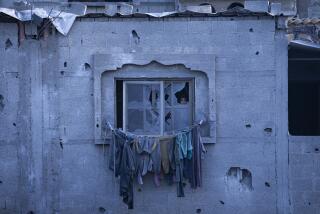Killing of Kurds Blamed on Baghdad : Gas Attack Envelops Iraqi Town in Cloud of Death
- Share via
HALABJA, Occupied Iraq — More than 100 bodies of women, children and elderly men lay in the streets, alleys and courtyards of this now-empty city, victims of what Iran claims is the worst chemical warfare attack on civilians in its 7 1/2-year-old war with Iraq.
Some victims hugged children in silent embraces, others sprawled in doorways. One family lay near a table set for lunch.
In another house, the cellar became the death chamber for residents trying to flee the heavier-than-air cloud--said by Iranian scientists to be a mixture of mustard and cyanide gases--that seeped down into their refuge to kill them.
Outside, the streets were littered with bloated carcasses of cattle and sheep, cats and dogs, all trapped by the chemical burst near the city center.
Iraq denies responsibility for what happened in this valley 150 miles northeast of Baghdad last Wednesday at 2 p.m. when, according to survivors, a single warplane appeared from the west and dropped one or more chemical bombs that dispersed a deadly yellow-and-w1751741541killing hundreds and perhaps thousands of residents.
Iran has estimated that 4,000 civilians died in Halabja either from gas poisoning or from the intensive Iraqi bombing that followed. The figure could not be independently verified.
Iraq said last week that its forces had long ago abandoned Halabja and did not consider the area important. Whatever happened here, an Iraqi communique asserted, was Iran’s responsibility.
The brutal assault on Halabja, if committed by Iraq, would seem to confirm other reports that Iraq has undertaken a systematic campaign to punish the Kurdish population that is supporting Iran’s military operations in the area.
THe evidence is plentiful that the Iraqi army was here in strength.
The gas attack came during a large military offensive by Iranian Revolutionary Guards and Kurdish guerrillas, who have penetrated 30 miles into Iraq and are now dug in along the shore of Lake Darbandi Khan, where a dam serves as a major hydroelectric power source for northeastern Iraq.
Artillery duels were still raging to the north and south of the lake when Western reporters traveled here under Iranian escort this week. Iraqi warplanes roared overhead, and random artillery shells gouged small craters into the nearby fields as reporters toured Halabja, Dojaila and the tiny hamlet of Anap, where another 80 bodies of civilian gas victims were heaped together on the roadside.
The bodies of dozens of dead Iraqi soldiers were strewn along the five miles of roadway between Halabja and Dojaila, where the heaviest fighting occurred last week.
But the starkest and most gruesome scenes of this distant battle set in a lush green valley flanked by snow-crested peaks are the quiet faces of the noncombatant dead: four small girls in traditional dress lying like discarded dolls by a trickling stream below Anap; two women cuddling in death by a flower garden; an old man in a turban clutching a baby on a doorstep.
Mustard and Cyanide Gas
In Tehran, Iranian medical specialists treating Halabja survivors said the gas cloud contained a mixture of mustard and cyanide gases. Iranian doctors said that other symptoms, such as severely depressed bone-marrow production, indicated that other chemical agents with longer-lasting effects had been mixed with the mustard and cyanide gases.
Hundreds of gas victims were evacuated to Tehran hospitals, where Western journalists saw them. Doctors said they were suffering from chemical burns on their skin, eyes and lung tissue.
Hamid Sohrabpour, an internist at a hospital in Tehran, said he had admitted 152 gas victims from Halabja.
“Almost all of our patients are civilian Kurdish people,” he said. “They have skin burns all over and in their lungs, and their most difficult problem is breathing.”
Iran said that in the course of the war, it has refrained from using chemical weapons in retaliation for Iraqi chemical attacks, but earlier this year Iranian officials said they have developed the capability to produce such weapons.
In Tehran, the head of Iran’s War Information Ministry told reporters Wednesday that Iranian troops “may be forced” to use chemical weapons against Iraq in retaliation for Iraqi chemical attacks.
“We hope that the Islamic Republic of Iran will not be forced to take such measures,” Kamal Khorazi said, “but it depends on the will of the (U.N.) Security Council in taking some measures against the use of chemical weapons” by Iraq.
Khorazi criticized the “international organizations” and members of the U.N. Security Council for “remaining silent” in the face of the attack on Halabja.
He said if the “deathly silence” continues in response to Iran’s protests to international organizations, “then maybe we will be forced” to use chemical weapons “to defend ourselves.”
In Washington on Wednesday, the Reagan Administration condemned Iraq’s use of chemical weapons as a “particularly grave violation” of international law and said there are “indications” that Iran had also used chemical artillery shells against Iraqi positions.
“We condemn without reservation any use of chemical weapons in violation of international law. We call upon Iran and Iraq to desist immediately from any further use of chemical weapons, which are offensive to civilization and humanity,” State Department spokesman Charles Redman said.
The International Committee of the Red Cross also condemned Iraq’s use of chemical weapons and called it a “new and tragic escalation” of the war.
More to Read
Sign up for Essential California
The most important California stories and recommendations in your inbox every morning.
You may occasionally receive promotional content from the Los Angeles Times.










